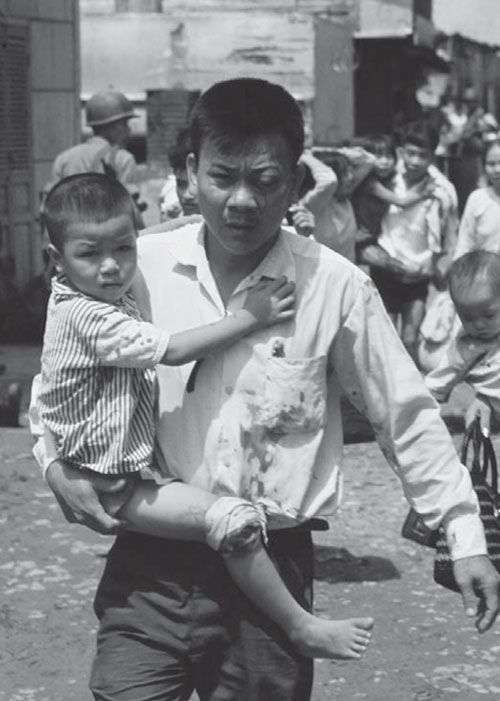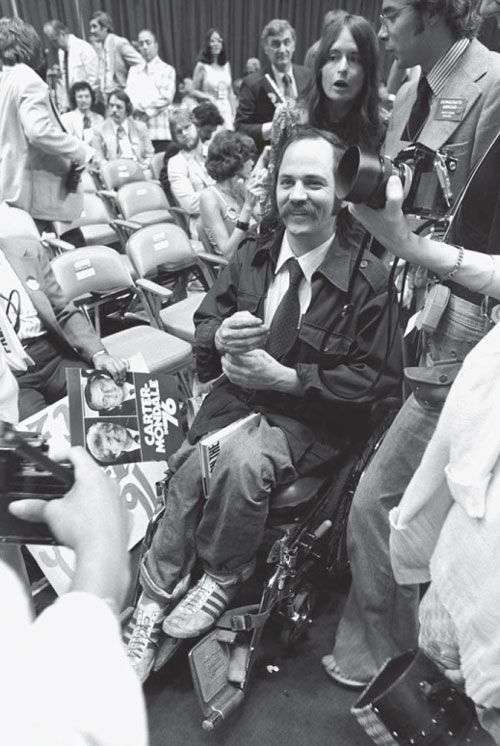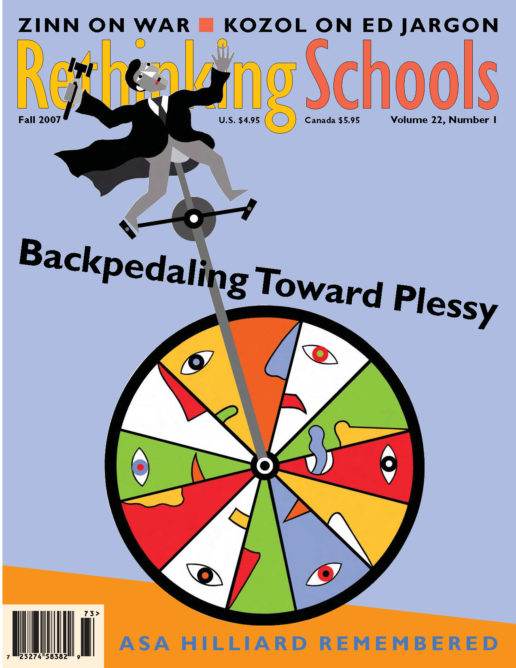‘This Madness Must Cease’
A Chapter on the Vietnam War from Howard Zinn's A Young People's History of the United States [Volume 2]
Illustrator: Courtesy Seven Stories Press / Corbis

Photo: Courtesy Seven Stories Press / Corbis
“Dear Mom and Dad,” an American soldier wrote home from Vietnam, “Today we went on a mission and I am not very proud of myself, my friends, or my country.” What kind of war would make a soldier feel that way? It was a war that made many Americans angry and ashamed of their country.
For nearly a decade, the richest and most powerful nation in the history of the world tried to defeat a revolutionary movement in a tiny, peasant country — and failed. When the United States fought a war in the southeastern Asian nation of Vietnam, it was modern military technology against organized human beings. The human beings won.
Vietnam also created the biggest antiwar movement the United States had ever seen. Thousands of people marched in the streets. Students organized protests. Artists, writers, and soldiers boldly spoke out against the war. The antiwar movement was loud and long-lasting. It helped bring the fighting to an end.
Communism and Combat
Before World War II, France controlled the Southeast Asian nation of Vietnam. When that war started, Japanese troops occupied the country. A revolutionary movement arose among the Vietnamese people, led by a Communist named Ho Chi Minh, to fight the Japanese. At the end of the war, the revolutionaries celebrated in Hanoi, a city in northern Vietnam. A million people filled the streets, rejoicing that their country was free of foreign control at last.
But the Western powers were already taking away that freedom. Before long, England and the United States saw to it that France regained control of Vietnam. Revolutionaries in the north resisted, and in 1946 the French started bombing them. It was the beginning of an eight-year war against the Communist movement, called the Vietminh. Before it was over, the United States gave a billion dollars in military aid, along with hundreds of thousands of weapons, to the French to use in Vietnam.
Why did the United States help France? The official reason was to stop the rise of communism in Asia. Communist governments had already come to power in China and North Korea. It was the height of the Cold War, when communism was seen as the greatest danger to America. But could there have been other reasons as well?
A secret U.S. government memo from 1952 talked about Southeast Asia’s resources. Its rubber, tin, and oil were important to the United States. If a government that was hostile to the United States came to power in Vietnam, it might get in the way of the United States’ influence and interests. In 1954, a memo in the U.S. State Department said, “If the French actually decided to withdraw [from Vietnam], the U.S. would have to consider most seriously whether to take over in this area.”
That same year, the French did withdraw from northern Vietnam. Under the peace agreement, the Vietminh agreed to remain in the north. The northern and southern parts of Vietnam were supposed to be unified after two years, and the people would be allowed to elect their own government. It seemed likely that they would choose Ho Chi Minh and the Vietminh.
The United States moved quickly to keep North and South Vietnam from being united. To bring South Vietnam under American influence, it placed the government in charge of an official named Ngo Dinh Diem. He was friendly to the United States, but the Vietnamese people disliked him.
Diem did not hold the scheduled elections. Around 1958, guerrilla attacks on his government began in South Vietnam. The guerrillas, called Viet Cong, were aided by the Communist government of North Vietnam. The Communist movement gained strength in the south. To the Vietnamese people, it was more than a war against Diem. It was a way of reorganizing society so that ordinary villagers would have more control over their lives.
Open opposition to Diem increased. Buddhist monks set themselves on fire and burned to death to protest against the South Vietnamese government. Under the international peace agreement, the United States could send just 685 military advisers to South Vietnam. It sent thousands more, and some of them helped fight against the guerrillas. The United States had entered into a secret, illegal war.
Next, the U.S. administration decided that Diem was not helping them control South Vietnam. The Central Intelligence Agency (CIA) secretly encouraged some Vietnamese generals to overthrow him. The generals attacked Diem’s seaside palace and executed him and his brother.
Three weeks later, the American president John F. Kennedy was assassinated in Texas. When his vice president, Lyndon B. Johnson, became president, he inherited the problem of Vietnam. In August 1964, Johnson told the American public that the North Vietnamese had fired torpedoes at a U.S. Navy ship. It was a lie. The ship had been spying for the CIA in Vietnamese territorial waters, and no torpedoes were fired. But the “attack” gave the United States a reason to make war on North Vietnam. Under the U.S. Constitution, only Congress could declare war. Instead, Congress gave the president power to take military actions in Southeast Asia without a formal declaration of war.
American warplanes began bombarding North Vietnam. They also bombed villages in South Vietnam where they thought Viet Cong were hiding. Sometimes they dropped a weapon called napalm, which is gasoline in jelly form, horribly destructive to human flesh. A New York Times article from September 1965 described the results:
In another delta province there is a woman who has both arms burned off by napalm and her eyelids so badly burned that she cannot close them. When it is time for her to sleep her family puts a blanket over her head. The woman had two of her children killed in the air strike that maimed her. Few Americans appreciate what their nation is doing to South Vietnam with airpower…. [I]nnocent civilians are dying every day in South Vietnam.
American troops also poured into South Vietnam. By early 1968 there were more than half a million of them there. As they raided villages looking for guerrillas, the difference between an enemy and a civilian seemed to disappear.
In March 1968 a company of American soldiers went into a village called My Lai. They rounded up the villagers, including old people and women carrying babies. Then they ordered the people into a ditch and shot them. The army tried to cover up what had happened at My Lai, but after word got out, several of the officers stood trial. A newspaper report of the trial described the massacre at My Lai:
Lieutenant Calley and a weeping rifleman named Paul D. Meadlo — the same soldier who had fed candy to the children before shooting them — pushed the prisoners into the ditch…. People were diving on top of each other; mothers were trying to protect their children…. Between 450 and 500 people — mostly women, children, and older men, were buried in mass graves.
Calley was sentenced to life in prison, but he served just three years of house arrest. An army officer admitted that many other tragedies like My Lai remained hidden.
As the war went on, the United States started bombing Laos, Vietnam’s neighbor. This was to keep the Viet Cong from operating bases there and to destroy supply routes used by the Viet Cong. The bombing in Laos was kept from the public. But when the United States later bombed another Southeast Asian country, Cambodia, the news reached the public and caused an outcry of protest.
“This Madness Must Cease”

Photo: Courtesy Seven Stories Press / Corbis
American firepower was enormous, but it wasn’t ending the resistance in Vietnam. And in the United States, the public was turning against the war. Some were horrified by its cruelty. Others simply felt that it was a failure that had killed 40,000 U.S. soldiers and wounded a quarter of a million more by early 1968.
President Johnson had stepped up a brutal war and still failed to win it. He became so unpopular that he could not appear in public without an antiwar demonstration. Protesters shouted, “LBJ, LBJ, how many kids did you kill today?”
From the start, Americans had protested against U.S. actions in Vietnam. Some of the first protests came out of the Civil Rights Movement — maybe because black people’s experience with the government made them distrust any claim that it was fighting for freedom. In 1965, young blacks in Mississippi who had just learned that a classmate was killed in Vietnam passed out a pamphlet that said: “No Mississippi Negroes should be fighting in Viet Nam for the White man’s freedom, until all the Negro People are free in Mississippi.”
The Student Nonviolent Coordinating Committee (SNCC), a big part of the Civil Rights Movement, said that the United States was breaking international law in Vietnam. It called for an end to the fighting. When six SNCC members invaded an Alabama induction center (an office for entering the armed forces), they were arrested and sentenced to several years in prison.
Julian Bond, a SNCC activist, was elected to the Georgia legislature. After he spoke out against the war and the draft, the others legislators refused to let him take his seat. The Supreme Court restored Bond to his seat, saying that he had the right to free expression under the First Amendment.
In 1967, Martin Luther King Jr. spoke about the war at Riverside Church in New York:
Somehow this madness must cease. We must stop now. I speak as a child of God and brother to the suffering poor of Vietnam. I speak for those whose land is being laid waste, whose homes are being destroyed…. I speak for the poor of America, who are paying the double price of smashed hopes at home and death and corruption in Vietnam…. I speak as an American to the leaders of my own nation. The great initiative in this war is ours. The initiative to stop it must be ours.
Catholic priests and nuns joined the antiwar movement. Father Philip Berrigan, a priest who was also a veteran of World War II, was one of many people who went to jail for destroying the records at offices of the draft board, where young men were required to register for military service. His brother Daniel, also a priest, was imprisoned for a similar act.
Thousands of young American men fled to Canada or Europe. Some were avoiding the draft. Others were soldiers, deserting. Antiwar feeling was strong among servicepeople, both soldiers and veterans. Some spoke out, risking punishment.
A Navy nurse was court-martialed for marching in a peace demonstration while in uniform. Two black marines went to prison for talking to others against the war.
One antiwar veteran told his story in the book Born on the Fourth of July. Ron Kovic enlisted in the U.S. Marines when he was 17. He was serving in Vietnam when shellfire shattered his spine and paralyzed him from the waist down. Back in the States, in a wheelchair, Kovic demonstrated against the war. He told how he was treated after being arrested during a demonstration:
“What’s your name?” the officer behind the desk says.
“Ron Kovic,” I say. “Occupation, Vietnam veteran against the war.”
“What?” he says sarcastically, looking down at me.
“I’m a Vietnam veteran against the war,” I almost shout back.
“You should have died over there,” he says. He turns to his assistant. “I’d like to take this guy and throw him off the roof.”
The growth of the antiwar movement couldn’t be stopped. When the bombing of North Vietnam had started in 1965, 100 people gathered in Boston to protest it. But on October 1, 1968, a nationwide day of antiwar activity, a 100,000 showed up in Boston and as many as 2,000,000 people took part across the United States.
Famous voices and ordinary voices were raised against the war. Arthur Miller, a well-known playwright, was invited to the White House. He refused to come. Singer Eartha Kitt did accept an invitation to the White House and shocked everyone by speaking out, in front of the president’s wife, against the war. A teenager who had won a prize was called to the White House to accept it. He came — and criticized the war.
Even some of those close to the government had had enough. Daniel Ellsberg, a former U.S. Marine, had helped write a top-secret history of the war for the Department of Defense. He and a friend decided to make it public. They leaked the “Pentagon Papers” to the New York Times, which published parts of the document.
By that time, Republican Richard Nixon had replaced Democrat Johnson as president. Nixon tried to get the Supreme Court to stop the Times from publishing the Pentagon Papers. He failed. The administration then put Ellsberg and his friend on trial. The trial was halted when unfair and illegal acts by Nixon’s own administration — an event called the Watergate scandal — became public.
By the fall of 1973, North Vietnamese troops were established in parts of South Vietnam. The American administration could see no victory in sight. After a final, brutal wave of bombing over the north, the United States signed a peace agreement and withdrew its forces. The South Vietnamese government still received American aid, but without the American military it could not hold off an invasion from North Vietnam. In 1975 the country was united under the Communist rule of Ho Chi Minh.
Vietnam was the first defeat to the global American empire that had formed after World War II. That defeat came from a revolutionary peasant army and from an astonishing movement of protest at home. Yet the rebellion at home was spreading beyond the issue of war in Vietnam.

